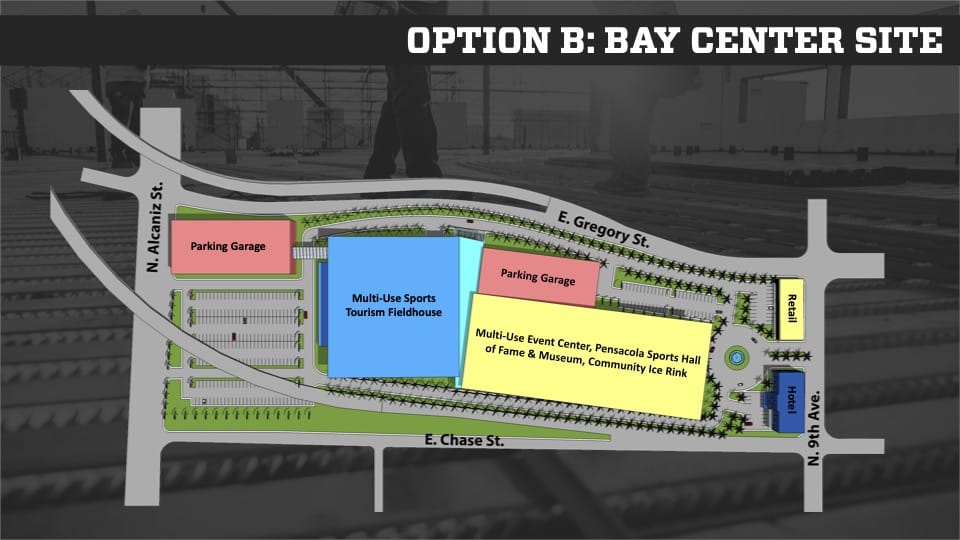
Seven years ago, Pensacola hotelier Jay Patel presented an ambitious plan, involving eight national companies, to create a $65 million public-private partnership to build a 6,500-seat arena, field house with a conference center, full-service hotel and retail.
- The multi-purpose facility, which would also host conventions, meetings, entertainment and other significant events, is proposed to be built on the former 19-acre ECUA Mainstreet Wastewater site owned by Quint Studer or on the existing Pensacola Bay Center location.

The driving forces behind the proposal were:
1) The Board of County Commissioners realized the Bay Center needed to upgraded or demolished but had balked at spending $5 million on the facility.
2) Mayor Ashton Hayward wanted to attract the New Orleans Pelicans’ proposed G-League Team to Pensacola, but the Bay Center did not meet NBA standards.
3) The 2016 study showed that sport tourism was viable and profitable for the Pensacola area. Read Escambia Sports Tourism Final Report February 2016

Details: Patel formed Pensacola Arena Development Partners LLC (PADP) for the project. Partner Hunt Development Group, a Texas-based investment company, would provide the money upfront to build the sports complex. The county would repay Hunt under a 30-year lease agreement.
- PAPD would use Triumph Gulf Coast funding, tourism development tax money (bed taxes), sales tax money, federal income tax credits and other government sources. He said private companies would cover any annual losses and, if the facility makes money, split profits with the county. Additionally, Patel said private backers would put $200,000 a year into reserves to help replace items in the facility in the future.
The sports complex’s plan includes a 100,000-square-foot field house that can accommodate 12 volleyball courts or 10 basketball courts. It also calls for a hotel, two 800-space parking garages, 450 surface parking spaces, and retail space on the northeast and northwest corners.
What happened: The Pelicans eventually chose Birmingham for its G-League team. The Birmingham Squadron opened its first season in Legacy Arena, which seats 19,000, in 2020.
- Triumph Gulf Coast was not interested. The hoteliers’ Destination Marketing Organization (DMO) refused to support adding a fifth cent to the bed tax. The Escambia County Commission was interested in using Local Option Sales Tax funds.
The PNJ opposed the project, citing the need for a “better public process.” The newspaper’s brain trust felt the county was “late to the game” in going after youth sports to drive tourism, pointing to facilities in Panama City, Destin and Orange Beach. [Note: The 2024 study shows youth sports tourism still thrives.]
Julian MacQueen, founder of Innisfree Hotels, wrote the commissioners about his objections to the PADP proposal. He pointed out that arenas, convention centers and convention hotels are not money-makers and are highly subsidized.
“Since 98% of all Convention Centers are not profitable (see the most recent legacy of the Okaloosa Convention facility), the concept is that the community will benefit in quality of life, and a spin-off to the tax base will be created in second-hand revenue through related businesses, like hotels, retail, and restaurants,” he wrote.
“While I do believe that government has a responsibility to subsidize public/private ventures, we need to be focused on where the biggest benefit is for our size community and its natural attributes.”
MacQueen believed that Patel’s proposal “strayed away” from Pensacola Sports’s original intent for the sports tourism complex.
“This project is simply too big, and the likelihood of a city and county of our size supplementing the Shortfall combined with the Lease Payment to the County is too great,” he wrote. “I feel the likelihood of a successful outcome is small, if not impossible, under the current LOI and scope.”
MacQueen recommended, “If we were to come back to our original intent and propose a reasonable sized Sports Facility, even with the huge financial commitment in our competitive set from Foley and Panama City to this sports market, I feel we could do something for our county that would make us all proud and not be saddled with version 2.0 of the existing civic center for decades to come.”
Patel tried again in 2019. The PADP project 2.0 involved constructing a field house between 80,000 and 100,000 square feet that would facilitate about 10 basketball courts or 12 volleyball courts and have a new 6,500-seat event center. Both venues would be developed to the east of the Bay Center, with that facility being demolished once the new facilities are complete. A parking garage component is also included. Price tag: $80 million.
The proposal had little support. The fieldhouse (indoor sports facility) would not be proposed again until this year.



